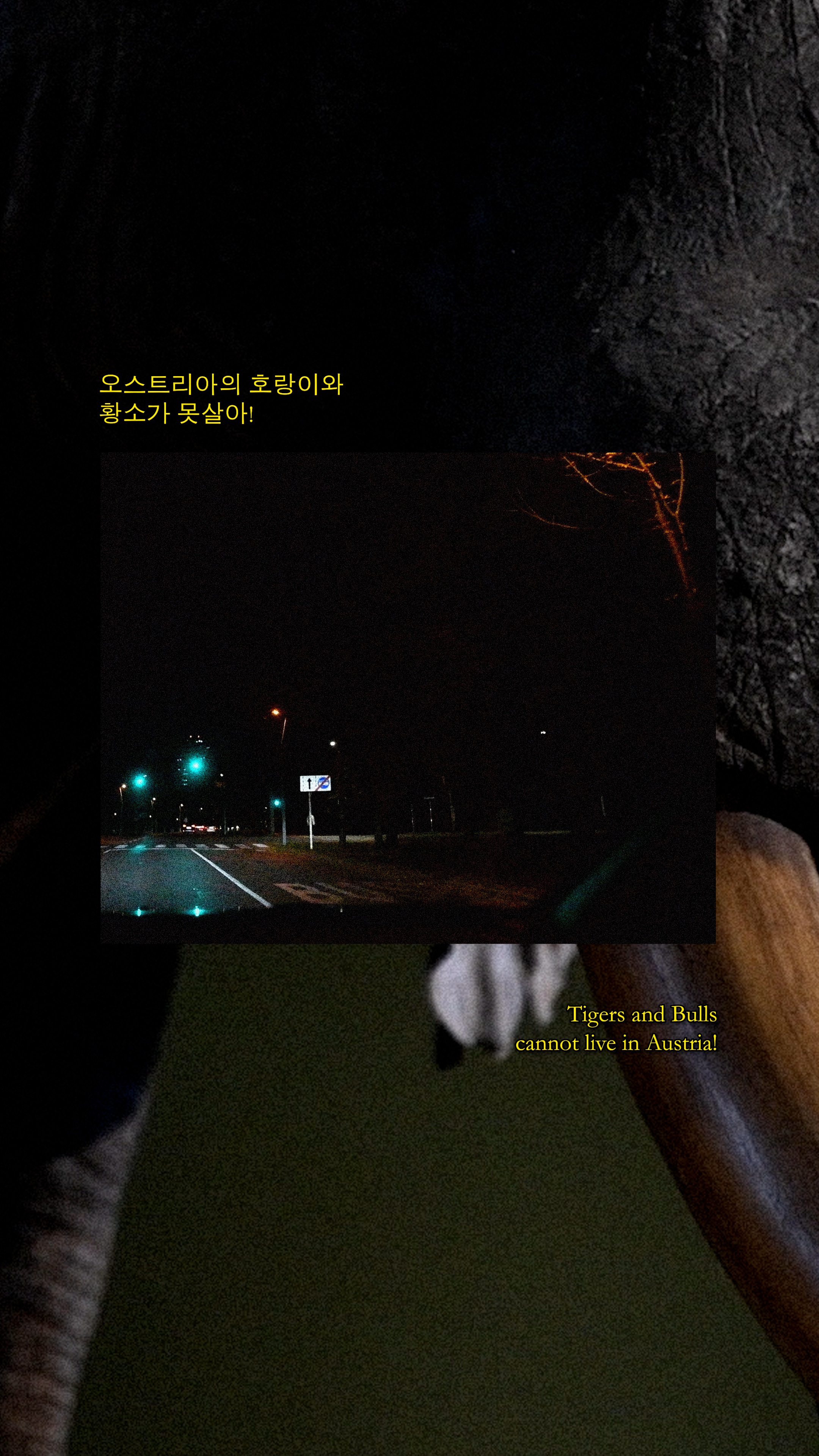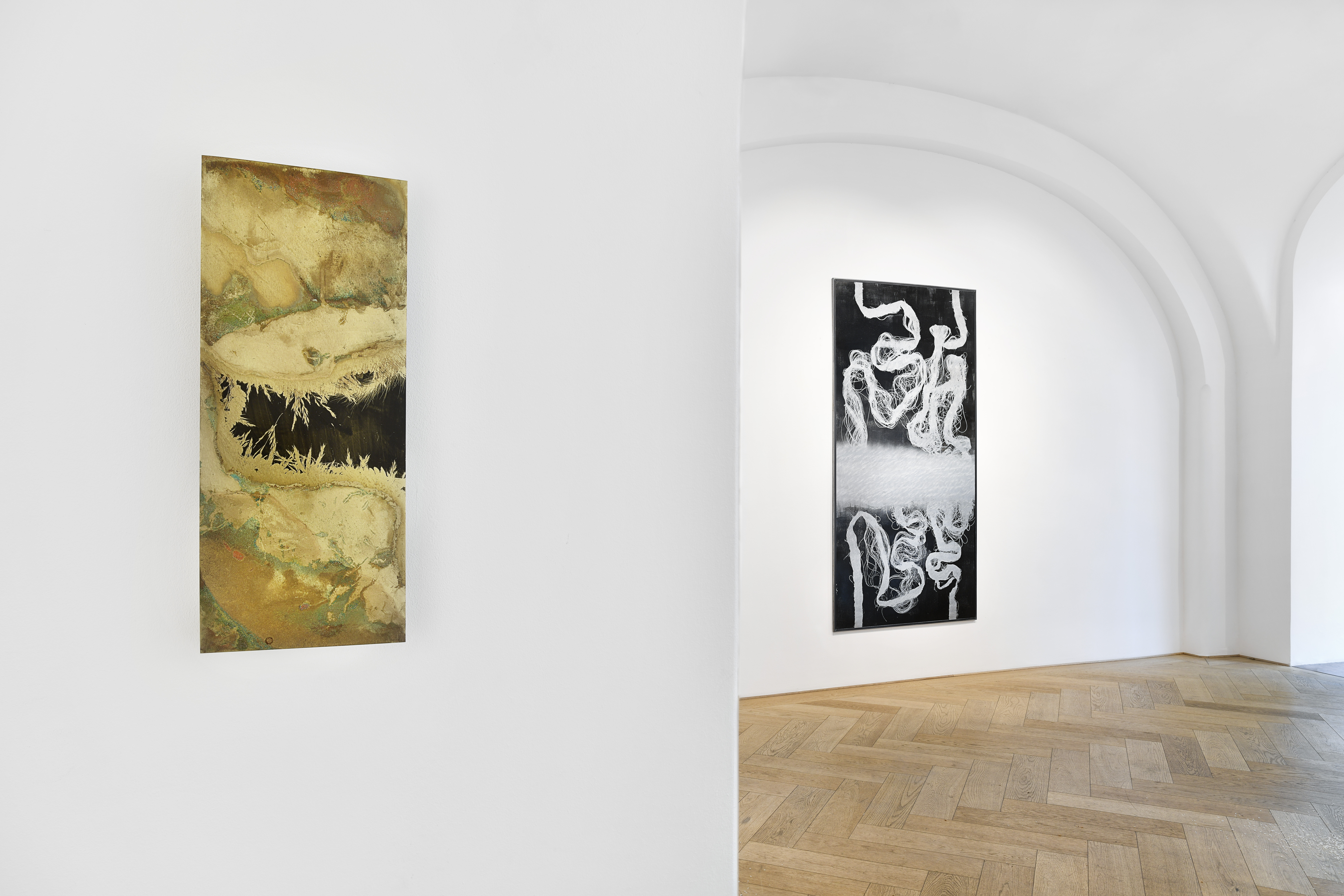Kaja Clara Joo ︎
Lurker
Online Catalogue: ︎ | Video Movie: ︎ | Edition: ︎
2023:
Long Durée: Videoinstallation
4-channel Video-loop, Steelpipes, Galvanized brackets, Rice
Bulgasari Manual: Photograms
Lasercut steel and brass, gelatine, photoemulsion, vinegar, installed with copperpipes and rice
Coup IV: Photogram
Gelatine and photoemulsion on aluminium in steelframe
“The Austrian-Korean artist Kaja Clara Joo (born 1991 in Vienna) is showing her new, room-sized installation LURKER. The title is borrowed from net jargon and refers to people who read discussions in internet forums or chats but do not actively participate in them. A “lurker” is someone who is present but does not make themselves known as an entity. The concrete form, intention and identity of the lurker remains mysterious and hidden...” (read more below)
Online Catalogue: ︎ | Video Movie: ︎ | Edition: ︎
2023:
Long Durée: Videoinstallation
4-channel Video-loop, Steelpipes, Galvanized brackets, Rice
Bulgasari Manual: Photograms
Lasercut steel and brass, gelatine, photoemulsion, vinegar, installed with copperpipes and rice
Coup IV: Photogram
Gelatine and photoemulsion on aluminium in steelframe
“The Austrian-Korean artist Kaja Clara Joo (born 1991 in Vienna) is showing her new, room-sized installation LURKER. The title is borrowed from net jargon and refers to people who read discussions in internet forums or chats but do not actively participate in them. A “lurker” is someone who is present but does not make themselves known as an entity. The concrete form, intention and identity of the lurker remains mysterious and hidden...” (read more below)




“As with numerous previous projects, including the MQ ARTBOX 2021 at MuseumsQuartier Vienna, the SPARK Art Fair 2021 (both with Smolka Contemporary) or the Bildraum 07 2022, Kaja Clara Joo is also pursuing a Gesamtkunstwerk idea with this new body of works, in which the audience is to be literally immersed. LURKER is composed of technically very differently executed works that all refer to each other in terms of content. The narrative material that the artist weaves could not be denser: sculpture, experimental photography and video merge to form an installation that revolves around the Korean mythical figure of Bulgasari.
This Bulgasari is also a lurker, it does not manifest itself figuratively, it only appears fragmentarily, and this, in turn, evokes a certain horror effect. Described as a “metal-eater” and monster and interpreted since the mid-1980s in North Korean trash cinema as a Godzilla-like figure bringing destruction, Kaja Clara Joo researched traditional Korean drawing for her idea of the Bulgasari and thus returned to the origins of the figure. The result is, among other things, implied body shapes, which the artist has realised from sheet steel and brass and worked with edible materials such as rice (with which the Bulgasari is fed), gelatine and vinegar. “I marinate my art, it’s almost like fermenting,” says Kaja Clara Joo. The outlines of organic forms – grasses and leaves, for example – that allude to the forest, the origin of the Bulgasari, are applied to the metal surfaces by means of photograms; traditional motifs and artistic practices meet high-end technology.
Transformation and metamorphosis play an eminent role in Kaja Clara Joo’s output. Her works are about making temporal sequences and processes visible, for example with surface reactions, as is fundamental to photography: “Time” as a linear, one-dimensional concept is permanently questioned. Both technique and medium as well as narrative attitude and perspective are in a constant state of flux. On the one hand, this can be explained by the artist’s biography. Having grown up partly in Korea, Joo understands the present as strongly steeped in history and tradition. “When I was sick, my grandmother would fetch herbs from the garden and make me a tea with them,” she says. “On one of our trips, I once saw a Bulgasari mural in a temple, which protects the temple from burglars.” Her own life story and experiences as well as cultural background act like a repertoire, which Joo makes use of in her artistic work. But it is also important to her to draw attention to the fact that history and stories can and must be told not only in one voice and from a singular point of view, but diversely.
This concern manifests itself particularly clearly in the four-channel video installation Long Durée in the middle of the room. Several screens are mounted on steel tubes, a story unfolds: a young couple is driving at night in a car, a heated argument breaks out. The reason for the dispute is the protagonist’s claim that she has seen a strange creature in the forest. When the situation escalates, the woman gets out of the car and decides to go in search of the creature. The path leads over an embankment, the protagonist loses her footing and slips, in free fall she changes age, appearance, gender and ethnicity. Behind the foliage and trees, the silhouette of the being she is looking for – the Bulgasari – is hinted at again and again. Finally, she is back in her partner’s car and the story returns to the starting point and begins again.” (read more below)








“The video installation is surrounded by the metal forms already mentioned, the Bulgasari Manual, in order to bring the premonition that drives the protagonist of the video work into the room. Puzzle-like fragments, however, only hint at the “being”. Teeth and ears, a tail, two paws – what is hiding there? The audience is thus given an almost physical experience that takes place somewhere between curiosity, haunting and doubt. The desire for grand narration and experimentation with narrative techniques is not only tangible in the video display and the metal sculptures, but also manifests itself in a series of drawings as well as in the large-format photogram Coup IV. What can be seen are the outlines of carrying straps applied by the artist to aluminium; in the middle of the picture, these shadowy bands blur or tear off. The Wool Drawings I-V, for which the artist places drawings on analogue photography, also address interruptions and backward movements of stringent lines and can thus be read as a poetic reference and plea for multi-perspective narration. At the same time, one also seems to be able to make out body parts, hair or fur of the mystical being again and again.
The examination of the Bulgasari figure brings an old story into the present and emphasises its topicality by addressing feelings of unease and the uncanny, but also trust, courage and (in)visibility. There is no more stringency, no more one-dimensionality: the most diverse voices and materials are used to speak and fabricate, a veritable narrative pull is created. Of course, the project is based on conceptual considerations, but LURKER also unfolds an irresistible material and narrative sensuality that is accessible even without background knowledge. The artist aims above all at the temporal level and softens it; past, present and future seem to coincide. Everything happens at the same time – a contemporary phenomenon and feeling that has accompanied us for some years, just think of the principle of multitasking, which drives us under superficial efficiency to do several “things” at the same time while running the risk of losing focus and priorities. “Simultaneity” is also celebrated in pop culture, for example in the Oscar-winning film Everything Everywhere All at Once from 2022, in which the protagonist, played by Michelle Yeoh, finds herself in a multiverse and can “travel around” in it. As in this film, in Kaja Clara Joo’s work the traditional diachronic timeline seems to be swept away by the synchronous vortex of events. In LURKER, media as well as sensory impressions permeate each other; the project is a veritable full-body experience. The artist once again proves her quality as an impressive storyteller, who merges an ancient plot that has lost none of its topicality with historical and contemporary techniques and our digitally dominated everyday world. “
Lisa Ortner-Kreil
Curator, Bank Austria Kunstforum Wien


